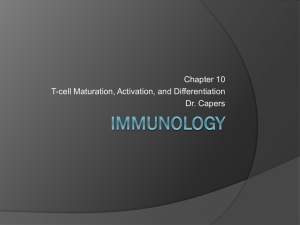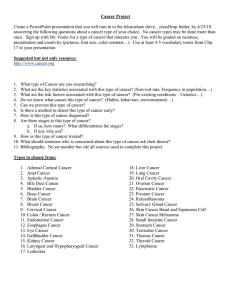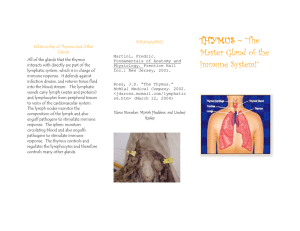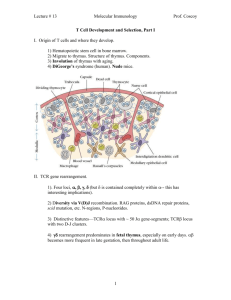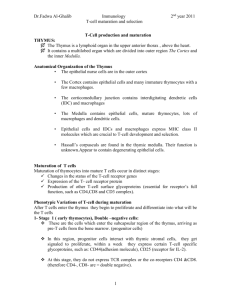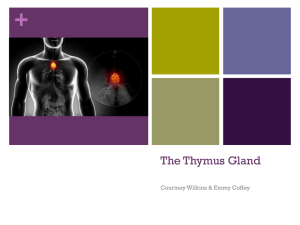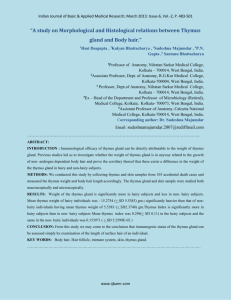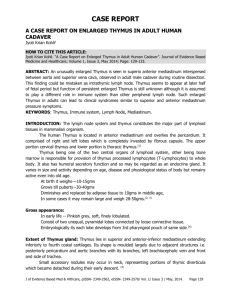Harvard-MIT Division of Health Sciences and Technology
advertisement
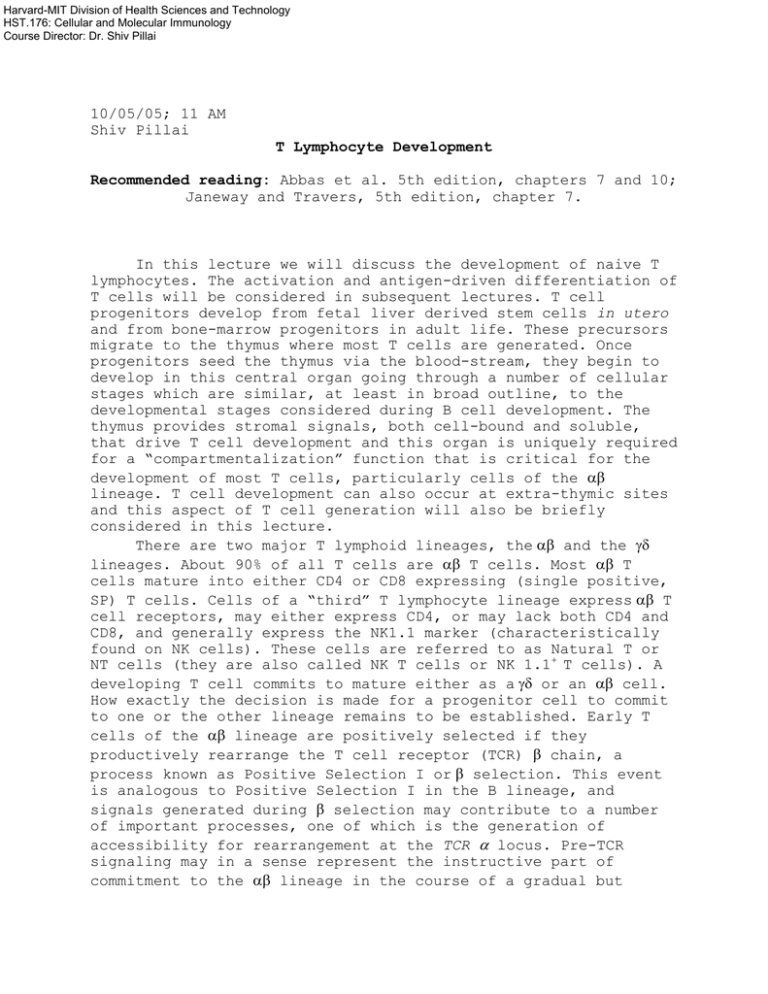
Harvard-MIT Division of Health Sciences and Technology HST.176: Cellular and Molecular Immunology Course Director: Dr. Shiv Pillai 10/05/05; 11 AM Shiv Pillai T Lymphocyte Development Recommended reading: Abbas et al. 5th edition, chapters 7 and 10; Janeway and Travers, 5th edition, chapter 7. In this lecture we will discuss the development of naive T lymphocytes. The activation and antigen-driven differentiation of T cells will be considered in subsequent lectures. T cell progenitors develop from fetal liver derived stem cells in utero and from bone-marrow progenitors in adult life. These precursors migrate to the thymus where most T cells are generated. Once progenitors seed the thymus via the blood-stream, they begin to develop in this central organ going through a number of cellular stages which are similar, at least in broad outline, to the developmental stages considered during B cell development. The thymus provides stromal signals, both cell-bound and soluble, that drive T cell development and this organ is uniquely required for a “compartmentalization” function that is critical for the development of most T cells, particularly cells of the αβ lineage. T cell development can also occur at extra-thymic sites and this aspect of T cell generation will also be briefly considered in this lecture. There are two major T lymphoid lineages, the αβ and the γδ lineages. About 90% of all T cells are αβ T cells. Most αβ T cells mature into either CD4 or CD8 expressing (single positive, SP) T cells. Cells of a “third” T lymphocyte lineage express αβ T cell receptors, may either express CD4, or may lack both CD4 and CD8, and generally express the NK1.1 marker (characteristically found on NK cells). These cells are referred to as Natural T or NT cells (they are also called NK T cells or NK 1.1+ T cells). A developing T cell commits to mature either as a γδ or an αβ cell. How exactly the decision is made for a progenitor cell to commit to one or the other lineage remains to be established. Early T cells of the αβ lineage are positively selected if they productively rearrange the T cell receptor (TCR) β chain, a process known as Positive Selection I or β selection. This event is analogous to Positive Selection I in the B lineage, and signals generated during β selection may contribute to a number of important processes, one of which is the generation of accessibility for rearrangement at the TCR α locus. Pre-TCR signaling may in a sense represent the instructive part of commitment to the αβ lineage in the course of a gradual but “leaky” instructive process. αβ T cells which have completed the program of receptor gene rearrangement subsequently undergo a second positive selection event (Positive Selection II - this is what is commonly referred to as “positive selection” by most people in the field), and may also be negatively selected at the CD4+/CD8+ double positive (DP) stage. PRE-TCR SIGNALING POSITIVE SELECTION I TCR CD4 CD8 IL-7 SIGNALING SCF/C-KIT SIGNALING CD4 + POSITIVE SELECTION II pro- T pre-T V α- Jα CD4 + 8 + POSITIVE SELECTION II NEGATIVE SELECTION CD8 + Non-productive β chain rearrangement Double Negative Death by Neglect Double positive Single positive REARRANGEMENT ELIMINATION RESPONDERS Figure 1 A simplified overview of T cell development. In the T lineage, negative selection leads to the deletion of self-reactive cells. It is still not fully understood how T cells that recognize most self-antigens, including many that are expressed in a highly tissue-specific manner are deleted in the thymus. A gene that might contribute in a poorly understood manner to the expression of a number of genes in medullary epithelial cells in the thymus is AIRE (for autoimmune regulator). In patients with APECED (autoimmune polyendocrinopoathy-candidiasis-ectodermal dystrophy) also known as APS (autoimmune polyglandular syndrome), AIRE is not expressed or is mutant and selected self-reactive T cells are not negatively selected. Although there is growing evidence for cells being given “another chance” if they encounter self-antigen during B cell development, there is at present no evidence to suggest that receptor editing occurs early in T cell development. Positive selection II in T cells is also closely linked to a lineage commitment decision - to make SP CD4+ or CD8+ cells. A simplified overview of T cell development (primarily of αβ T cells) is provided in Figure 1. Homing of progenitors to the thymus During fetal life T cell precursors leave the fetal liver in waves and colonize the rudimentary thymus at precise stages of development starting from day 11 of gestation (dE11). The first wave of precursors that seed the thymus before dE13 give rise to all the T cells that are produced by the thymus during gestation and the first week after birth. A second wave of progenitors from the fetal liver seeds the thymus after dE13 and this produces T cells that begin to dominate the repertoire from about day 7 after birth. After birth, however, there is a steady exodus of progenitors that leave the bone marrow and home to the thymus. How exactly waves of precursors are generated during fetal life is unclear. Why do T cells develop primarily in the thymus and not elsewhere? If any organ has been deified by immunologists it is the thymus! It has been described as the “maestro” or the “master orchestrator” of the immune system. Some of the implied “intelligence” attributed to selection processes in the thymus, particularly the process of MHC restriction, may need to be thought through from a strictly developmental, but perhaps teleologically less exciting, viewpoint (see discussion below). Why exactly do we need the thymus? Are there any unique trophic factors in this organ that do not exist at other anatomical sites? Is there any reason why stromal cells in the bone marrow or other cells elsewhere cannot induce positive and negative selection? It appears that the unique architecture of the thymus is essential during lymphocyte development. While the thymus does provide the signals for commitment and differentiation as described below, recent studies suggest that T cell development cannot proceed efficiently in extrathymic sites, because of a feedback inhibition effect. It has been demonstrated that recently generated mature T cells inhibit the further development of precursors. While bone-marrow precursors can give rise to mature SP αβ T cells in the bone marrow itself, mature cells provide feedback signals that prevent the efficient maturation of precursors within this compartment. In in vitro studies, when DN T cell precursors in the bone marrow are separated from mature cells (largely of recirculating origin), these precursors can quite efficiently generate SP CD4+ and CD8+ cells. In the presence of mature T cells, in vitro T cell maturation is relatively inefficient. It has been suggested that perhaps because T cells and their cytokine products can potently influence hematopoiesis, it is advantageous for T cell production not to occur in the immediate vicinity of blood cell generation. Accordingly, a negative feedback loop may have evolved in vertebrates by which mature T cells inhibit the generation of T cells from precursors. Although such a scheme of things is totally speculative, these observations lend support to the view that the underlying design of the thymus is to provide an environment that overcomes the process of feedback inhibition. One major feature of “thymus design” is the compartmentalization of precursors in the cortex and of more mature cells in the medulla. It is likely that in such a set-up, more mature T cells are physically segregated from immature T cells and are thus unable to negatively influence T cell development. The development of the thymus The thymus is made up of a highly organized network of epithelial cells, mesenchymal cells, and T lineage cells and their progenitors. The thymic epithelium, fibroblasts, dendritic cells, and macrophages together make up the thymic stroma. The latter two cell types are of bone-marrow origin. Dendritic cells in the thymus may be however of myeloid or lymphoid origin as discussed above, and thymic macrophages may also be fairly diverse. The early, relatively undeveloped, thymic primordium is formed by the fusion of the endoderm from the third pharyngeal pouch with the ectoderm of the third branchial cleft. The development of this thymic anlage depends on the inductive influence of the surrounding neural crest derived mesenchyme. In the chick it has been suggested that pharyngeal pouch endodermal cells alone can give rise to thymic epithelial cells. In the mouse both the ectoderm and the endoderm are believed to contribute to the development of these epithelial cells. In the nude mouse, discussed below, ectodermally derived epithelial cells fail to develop. The importance of the neural crest derived mesenchyme in inducing the development of the thymic primordium has been supported by experimental ablation studies. In man, the DiGeorge syndrome (discussed in the lecture on immunodeficiency) might result from a defect in neural crest derived mesenchyme. Mice in which the Hox-a3/Hox 1.5 gene has been knocked out have athymic embryos along with other craniofacial abnormalities. Whether the underlying defect is in cells of ectodermal, endodermal, or mesenchymal origin remains to be established. However the similarity of the thymic defect to that noted in the DiGeorge syndrome suggests a defect at the level of the mesenchymal induction of thymus development. The thymic primordium is invaded by blood vessels and associated mesenchyme of mesodermal origin. Once the blood supply to this organ has been established, bone-marrow derived macrophages, thymic dendritic cells, and thymic progenitors can enter. Further development of the thymus into distinguishable cortical and medullary regions requires the development of early T cells There is a decline in recent thymic emigrants with age, and a drastic reduction after thymectomy. It has been demonstrated that patients with human immunodeficiency virus (HIV) infection can also generate new peripheral T cells after effective antiviral therapy. The issue of new T cell generation with age has been conveniently examined in the chick because of the discovery of a cell-surface marker that is expressed only on recent thymic emigrants. These studies have revealed that while fewer new T cells are generated with age, T cell generation continues at some level throughout adult life. Some T cell function persists after thymectomy, and it is possible that a small number of new T cells are generated after thymectomy. It is possible that new T cells could be generated in extrathymic sites (discussed below) such as the bone-marrow and intestinal cryptopatches, and that no thymectomy is ever perfect - perhaps some residual thymic tissue persists after the most meticulous extirpation. Summary and Perspective Hematopoietic stem cells generate partially committed progenitors which migrate to the thymus and progressively become more committed to the T lineage. While intermediate stages of commitment may be defined by surface markers, little is understood of the actual commitment process itself. GATA-3 represents a transcription factor is required for entry into the T lineage. Most T cells belong to the αβ lineage and develop in the thymus. Commitment to the αβ or γδ lineages may involve a “leaky” instructive mechanism, but it remains possible that stochastic events drive this developmental decision. A critical function of the thymus is to compartmentalize and separate precursor cells from more mature cells which can inhibit the maturation process. Precursors develop in the thymic cortex. Cortical epithelial cells provide poorly understood cell surface and extracellular matrix ligands for receptors on T cell progenitors. They also secrete IL-7 and SCF which are required for the survival and proliferation of T lineage precursors and either directly or indirectly influence the commitment process. TCRβ gene rearrangement is induced in cortical thymocytes and while Eβ (the enhancer in the TCR β locus) is required, the actual cell surface signals that trigger accessibility factors, and the specific cis-acting sequences that bind to these unknown accessibility factors remain to be identified. The coming years will probably see the identification of the extracellular ligands and receptors that might drive commitment, and gene targeting experiments will undoubtedly be conducted to establish which specific cis-acting motifs in the TCRβ locus are required for the initiation of V(D)J rearrangement at this locus. TCR β chains contribute to the formation of the pre-TCR which probably signals constitutively in a ligand independent fashion to select cells which have made in-frame rearrangements at the TCRβ locus. The pre-TCR is required for survival and subsequent proliferation of selected pre-T cells and for the initiation of allelic exclusion probably both at the level of the transient induction of Rag-2 degradation and the subsequent loss of recombinational accessibility. Pre-TCR signals also probably contribute to the induction of TCR α accessibility in an Eα dependent manner, although the specific cis-acting motifs and accessibility factors remain to be identified. Following β selection, DP T cells may be successively positvely and negatively selected. Positive selection depends on the induction of TCR signaling by low/moderate affinity MHCpeptide ligands. High affinity MHC-peptide ligands induce deletion of T cells and T cells that do not recognize MHC like shapes probably “die by neglect”. Positive selection is initiated by MHC-peptide ligands on cortical epithelial cells and negative selection is completed in the medulla by MHCpeptide complexes which bind with high affinity to cognate TCRs. AIRE may facilitate the expression in thymic medullary epithelium of specific genes and thereby contribute to the generation of tolerance. The specificity of T cells for self-MHC is engineered by positive selection and this specificity is called MHC Restriction. This term is somewhat overemphasized by immunologists and means much less than it is made out to! Positive selection is accompanied by a lineage commitment decision whereby DP cells shut-of expression either of CD4 or CD8. Lineage commitment may involve instructive processes or may be achieved by an asymmetric commitment mechanism which is stochastic in part. Even if the lineage commitment process is completely stochastic (and this is unlikely), selection processes must subsequently dictate the survival of cells with TCRs being matched, based on the class of MHC recognized, with either the CD4 or CD8 coreceptors. A significant proportion of γδ (and some αβ) T cells may develop extra-thymically, an important site for IEL generation being intestinal cryptopatches. Invariant γδ T cells that develop in a fetal thymic environment from fetal HSCs, are not selected by antigen, but are actually programmed to initiate very specific patterns of TCR γ and δ gene rearrangement. NT cells express canonical Vα14-Jα281 rearrangements but appear to emerge primarily in the thymus by the selection of specific αβ T cells driven by CD1 ligands expressed on cortical thymocytes. Selected Reviews Anderson, G., Moore, N. C., Owen, J. J. T., and Jenkinson, E. J. (1996). Cellular interactions in thymocyte development. Annu. Rev. Immunol. 14, 73-99. Fehling, H. J., and von Boehmer, H. (1997). Early αβ T cell development in the thymus of normal and genetically altered mice. Curr. Opin. Immunol. 9, 263-275. Fischer, A., and Malissen, B. (1998). Natural and Engineered disorders of Lymphocyte Development. Science 280, 237-243. Zuniga-Pflucker, J. C., and Lenardo, M. J. (1996). Regulation of thymocyte development from immature progenitors. Curr. Opin. Immunol. 8, 215-224. Study Questions 1. Describe the affinity model for positive and negative selection of T cells. 2. Discuss the functions of the pre-TCR. 3. Explain how transgenic or knockin mice have been used to explore T cell tolerance.
